

FOOD ENLIGHTENMENT
Curated Writing About The World of Food
Primer: Coffee Brewing 101
"I've used a French press, an auto-drip, and a pod machine. Nothing can touch the rich aroma and taste of a good, basic percolator." —Amazon.com user
"Percolated coffee is thin, bitter, overdone swill." —Coffeegeek.com user
Drip
Coffee Websites
Coffee Related Directories
Links to Manufacturers
In the face of impassioned, contradictory, and sometimes incendiary assertions of coffee drinkers from all corners, we maintain our even-handed perspective by reminding ourselves of a couple of things. First, making and drinking coffee are distinct from most other culinary activities because they are every-day routines. Second, the subjective experience of your first morning sip is likely determined as much by what you're used to than by the method used to brew the cup. If you drink your coffee unsweetened, a half teaspoon of sugar might render your favorite brew undrinkable. If you usually start your day with a cup of instant decaf, a cup of French-pressed dark roast may seem unpalatably thick and bitter, and leave you wondering why you're talking faster than normal. Also, because coffee is a daily routine, convenience is an important part of the equation.
The purpose of this article is to survey the various paths that coffee devotees take in pursuit of the ultimate home brew. In the Resources section at the end of this article, we've included links to sites where you'll find in-depth examinations about myriad coffee topics, including the selection and purchase of coffee beans. This article will address brewing processes, and describe the most popular methods for brewing coffee at home:
- Percolator
- Drip (auto-, manual, Chemex)
- French Press
- Stovetop espresso
- Neapolitan
- Vacuum
- Turkish
- Boiled
- Vietnamese
- AeroPress
- Concentrate
- Pod machines
In this article, we do not cover stand-alone high-pressure espresso and cappuccino machines.
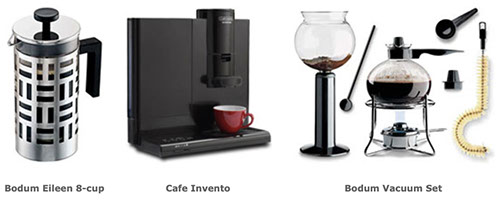
"Cuppers", representing an expert group in the coffee drinker spectrum, might express opinion thusly: "This iconoclast Sumatra displays an unexpected cleanliness and sweetness in the cup, along with an enjoyable winy-ness, accompanied by a syrupy body and sweet herbal notes that reveal a noticeable flicker of acidity." No matter how preciously they express their feelings, cuppers offer the lesson that practice makes perfect both for the procedures that produce a great cup of coffee (choosing/acquiring good beans, and roasting, grinding, and brewing them), and in training the palate to recognize coffee attributes of which we creatures of habit may be unaware.
Brewing Basics
Before describing each coffee brewing option, let's review the basic factors common to all coffee brewing methods. Ground coffee beans and water are usually the only two ingredients used in the brewing process. Even Sanka is 100% coffee. The brewing variables for the beans (which we'll presume to be of excellent quality, and to have been roasted to the perfect darkness) are grind consistency and quantity. Most brewing methods call for a particular consistency, sometimes lending their name to be used as a label. For example, espresso grind is powdery fine, whereas French press grind is fairly coarse.
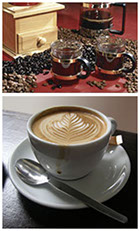 When possible, grind whole beans immediately before brewing because the essential oils inside the bean, which give coffee its flavor and aroma, begin to oxidize and evaporate immediately after grinding.
When possible, grind whole beans immediately before brewing because the essential oils inside the bean, which give coffee its flavor and aroma, begin to oxidize and evaporate immediately after grinding.
The water purity and quantity are the factors that most affect the brewed result. We recommend using filtered water or spring water. Faucet filters and filtered pitchers are usually effective at removing unwanted tastes from tap water without stripping it of minerals that help bring out the natural flavors of the coffee. The built-in water filters installed on some auto-drip machines may be effective as filters, but they require vigilant changing to prevent bacteria buildup.
The brewing process consists of heating the water (concentrate brewing sometimes uses cold water), and then causing it to come into contact with the grounds. The temperature of the water and the duration of the contact between the ingredients are the important factors in this action. It's generally agreed that that the ideal water temperature for brewing coffee grounds is between 190—205 F (88—95 C). The fussiest of coffee connoisseurs have been known to specify 199.4 degrees F (93 C) as the optimum temperature, likely a specious admonition given many variables. All coffee making methods use one or more of the following actions to brew the water and grounds: boiling, pressure, gravity, steeping (also called infusion).
Percolators
The percolator, invented in France in 1827, was the most popular type of home coffee maker in the US for decades, first as stovetop pots in the early 1900s, and later as stand-alone electrics from the early 1950s until the early '70s, when drip machines began to catch on. While the newer percolators sometimes employ automatically controlled heating elements and a valve to limit water flow, the criticism of this brewing method—that the coffee grounds are over-extracted, resulting in a thin, bitter brew—remains a concern for older-style percolators.
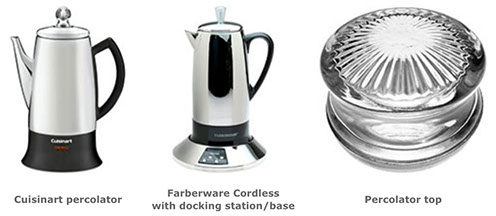
In a percolator, a fairly coarse grind of coffee is placed in a cylindrical, perforated canister. The canister is attached to the top of a hollow vertical tube, and inserted into a pot, above a quantity of cold water. Heat is applied to the water, forcing the water up and out of the vertical tube. The water then seeps through the canister of coffee grounds, and falls back into the water in the bottom half of the pot. Depending on the individual pot used, sometimes the water is heated to a boil and/or re-heated (boiled again, in some cases), and forced up the tube, to drip onto the now soggy grounds, in a continuing cycle of extraction. In most percolators, a glass dome is mounted into the cover that fits on the pot. This dome is situated directly above the opening of the vertical tube in the pot. The water bubbling out of the tube is visible through the glass dome as it percolates. Unfortunately, this typically signifies that the percolator has overheated the water and boiled the grounds, extracting too many acids and unwanted flavors along the way, resulting in a thin, bitter brew. As long as the percolating continue, the recycling of the bitterly brewed water continues.
There are two applications for which we embrace percolators: over a campfire, and at large gatherings where a pot is needed to brew and keep warm a large quantity of coffee. For a campfire, a manual pot is required, along with vigilance against overheating and re-cycling. For gatherings, there are many urn choices that will brew from 20—100+ cups efficiently. Generally, while the hotter brewing temperatures used in a percolator, over which the user has little control, produces a lot of coffee aroma in the kitchen, the flavor of the brew is not as fresh and the texture not as rich as in brews using other methods.
Drip: Automatic, Manual, and Chemex
Automatic-Drip
Automatic drip brewing has been the most popular coffee making method in the US and other countries for more than thirty years (Mr. Coffee introduced the first auto drip machine in 1972). 24 million auto drip coffeemakers are sold every year in the US. While purists cite several aspects of the drip brewing process that can compromise the quality of the coffee, auto drip machines are more popular than other types of brewers because they're convenient. They are available in a wide array of styles, formats, and prices, and they provide the easiest way to make a good pot of coffee, especially a large pot.

In an auto drip machine, water is heated in a reservoir, usually at the back or top of the machine, and dripped (sometimes after being pumped through a tube from the reservoir) over grounds held in a porous filter, after which it drips as coffee into a pot, carafe, or cup. This is simply gravity at work.
One of the criticisms leveled against auto drip machines is that the water temperature at the point when it begins to drip over the grounds is often impossible to control, and is often too low. Many of the less expensive machines, with 900 watts or less of power, aren't capable of heating the water to 190 degrees. Some of the models priced near the high end have brewing temperature and brew strength controls, and some machines—those made by Bunn, for instance—have reservoirs in which the water remains heated, reducing brewing time for a 10-cup pot from a typical 5—10 minutes to three minutes. Because most machines don't have a temperature indicator, there's no way of knowing for sure how hot the water is during extraction, short of short of rigging up a thermometer.
Another aspect of the process that is difficult to determine and impossible to control with an an auto drip machine is how uniform the contact is between the water and the grounds. Are the used grounds in your filter basket soaked through because the water was distributed evenly over the grounds? Or is it because osmosis occurred toward the end or after the brewing process? Did the water fall primarily into the center of the basket during the operation, over-extracting those grounds and barely wetting the grounds on the perimeter of the basket, leaving them under-extracted? In that case, the resulting brew would be both bitter and weak. In most cases enough water accumulates in the filter to soak all of the grounds before dripping into the pot below, but evenness of extraction is one of several brewing variables you will cede control over when using an auto drip machine.
Another concern with this brewing method is the filter. Paper filters can trap some of the essential oils, depriving the brew of flavor, while different filters can impart an unwanted taste. Re-usable metal or nylon mesh filters, are usually an improvement, provided they are kept clean.
Finally, coffee in a glass pot atop a warming plate — the most common configuration of auto drip machines — will start to go stale after about twenty minutes. Thermal carafes, which will keep the brew at optimum serving temperature range (typically 160-175 degrees), became popular in coffeemakers in the 1990s, and are a big improvement over the standard glass pots. Interestingly, a cup of coffee zapped for ninety seconds in a microwave, after sitting for hours in an airtight thermal carafe will taste fresher than a cup poured from an open, heated pot forty minutes after it was brewed.
Today's home auto drip machines are available in models that will brew anywhere from a single cup to a 14-cup pot, and they come with an array of automatic features: 24-hour programmable timers; audible alert tones; adjustable automatic shut-off; digital clock and brew indicators; small batch settings; built-in water filters; brew pause feature; double-wall insulated thermal carafes; variable brew strength control; self-clean cycle; and built-in bean grinder.
Manual-Drip
Coffee can also be drip-brewed manually, most commonly with a funnel-shaped holder, usually plastic or porcelain, that accommodates a disposable paper filter, and that is placed on top of a receptacle — a cup or mug for a single serving, a pot or carafe for a larger batch. By heating the water manually in a separate kettle or pot, the brewer can maintain accurate control of water temperature when the water makes contact with the grounds. Another manual drip process uses the Chemex brewer, a one-piece, hourglass-shaped, heat-resistant glass beaker that was marketed by the Chemex Corporation in 1942. The pots are available today in 3-, 8-, 10-, and 13-cup models, and range in price from $30—$80. Thicker paper filters are used with the Chemex than in other drip methods; consequently, the infusion process takes longer. The process calls for an initial wetting of the coffee grounds with the hot water, which allows them to "bloom" and release some of the carbon dioxide trapped in them. 20—40 seconds after this initial pour, the remaining water is added, sometimes in stages. This process requires more work than for ther manual drip methods, but the brew is noticeably richer.
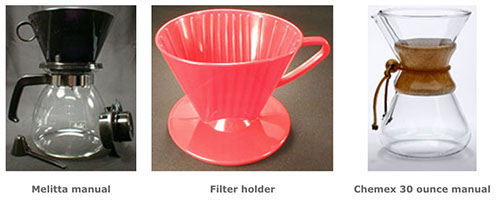
The manual drip brewing method obviously forgoes some features and functionality of the the auto-drip approach; however, it has its advantages. Control can be maintained over the water heating and distribution steps. It's easier to clean the components of a manual drip machine, and the manual units are usually less expensive. Finally, the manual models usually take up less counter space.
French Press
(also known as Plunger Pot, Coffee Press, and Cafetiere)
The French press reduces brewing to its elegantly simple essence. It's usually configured as a cylindrical jar (often glass, sometimes stainless steel or plastic), with a tight fitting metal plunger, a lid, and a handle. The medium-to-coarse coffee grounds are placed at the bottom of the pot (jar), and then heated water is poured over the grounds. The lid is secured, followed by 3—6 minutes of steeping. Then the plunger, which has a fine, wire mesh screen at its bottom is pressed down inside the cylinder to the bottom where it compresses, strains, and segregates the grounds. Because of the continual direct contact between the water and the grounds, the pressure applied, and the lack of a paper filter (like those used in many drip machines) that can trap some of the flavor components, the resulting brew is more complete, and has more body than that made with a drip machine. Also, because the water is heated separately and added to the grounds manually, the brewer has precise control over water temperature and steeping duration. A drawback is that, after the first servings of the finished coffee are poured from the pot into cups, the water that remains in the press continues to extract elements from the grounds, though they be compressed and confined under the plunger filter. To keep the remaining brew from over-steeping and becoming bitter it should be transferred to an insulated container.

Several manufacturers, including well-known Danish company Bodum, offer French presses in various styles starting at $15, including portable models, models with thermal carafes, and even electric models.
Stovetop Espresso, or Moka Pot
Espresso is a strong, concentrated brew made by using pressurized steam to force water through darkly roasted, finely ground coffee beans, that are densely compacted. The familiar pot pictured below is a Moka Express, created in 1933 by Alfonso Bialetti to make espresso on a stovetop. Pots with that original design, in three parts (bottom, top, and strainer compartment that fits between them) of aluminum, with a bakelite handle, are still made in a range of sizes in Italy by the Bialetti company. Several other manufacturers around the word make versions in different styles, including a few electric ones. Prices start at $15; the least expensive Bialetti is $19.
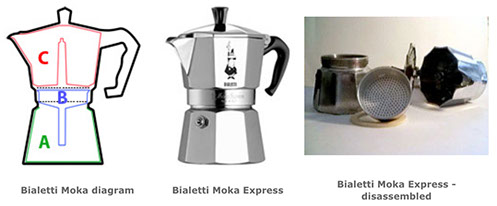
In the diagram of the Moka above, the bottom section, A, is where the water goes. The coffee, ground almost to a powder, is placed in middle section B, a shallow canister with funneled metal filters making up its top and bottom. The top of the pot, C, is tightly attached, usually screwed on. There are rubber gaskets between each two parts, which create air-tight seals so that when the pot is placed on the stove and the water is heated almost to boiling, steam is created, building up pressure and forcing the water up through the coffee grounds and into the upper chamber via a funnel shaped filter. A safety valve can be used to release excessive pressure in the bottom chamber.
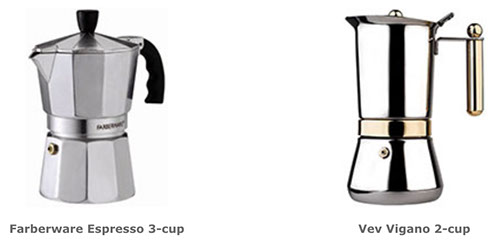
Bialetti claims that 120 million cups of this brew are made internationally every day. We don't know whether Italians consider stovetop espresso "real" espresso, or whether they care. Meanwhile, some coffee gourmands shake their heads and wag their fingers at such a proposition. One prevalent opinion among such experts is that the pressure a stovetop pot can produce is insufficient (they regard 9-10 atmospheres as sufficient) to properly extract and emulsify the oils in the ground coffee. In their view, the resulting brew, while noticeably thicker than drip coffee, and with a higher amount of dissolved solids, lacks the body and, more critically, the crema (foam) that forms at the top of the brew, made by the big commercial machines used at your favorite café.
Neapolitan
Similar to the Moka in form but actually a drip brewer for the stovetop, the Neapolitan is a two-section pot, one section of which fits upside down on top of the other, with a filter basket between them. Water is placed in the bottom and brought almost to a boil. Then the unit is turned upside down, and the water filters down through the grounds and into the (now) bottom section of the pot, which has a pouring spout. A medium to fine grind of darkly roasted beans is usually used, and, because of the filter design, the water drips more slowly through the grounds than with most gravity-brew methods. This increases the infusion duration, producing a stronger brew than that from other drip methods. With some practice, the brewer can learn exactly when to flip the pot so that the water temperature is ideal.
Originating in France, not Naples as the name implies, this rich brew is particularly popular in Italy (if not always made in a pot like the Alessi, pictured below left, $378). These aluminum or stainless steel pots come in a variety of sizes and styles. Prices start at around $20.

Vacuum Brewing
Vaccum brewing uses pressure twice during the process to move the water from one place in the brewing device to another. Since this method was patented in France in 1842, its popularity has continually waxed and waned as result of the availability of reliable vacuum pots and fashion. Here, in the early 21st Century, we are in a pronounced waxing phase, likely somewhat due to the intriguing look of the double glass-globe pot used. Pots available today range from about $30—$250; some of them have a retro design, others are fairly space-age, as shown below.
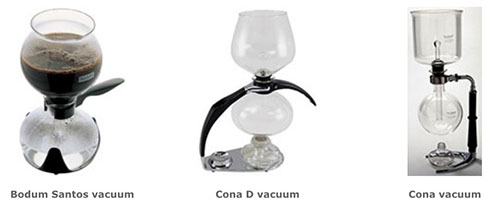
In the vacuum brewing process, water is placed in the lower globe, and coffee grounds are placed in the upper globe, where they sit on top of a spring-loaded plug with a cloth or nylon filter. The water is heated to a boil, raising the air pressure below so that water is forced up through a glass tube into the upper chamber where it mixes with the coffee. When almost all the water has siphoned up, the heat source is removed and the pressure in the bottom globe decreases, a vacuum is created and the brewed coffee is drawn back down, through the filter to the bottom container, at which point it can be poured into cups. Many people say they love this brewing method, not because the process is impressive looking, but because it makes a "clean" cup of coffee. Because the water is around 212 degrees when it mixes with the grounds, and control over the extraction time is limited, coffee brewed in this manner is fairly thin, comparable to drip brew in body.
Turkish Coffee
Also known as Greek coffee, or Middle Eastern coffee, the brewing method for this thick, flavorful beverage is as direct as any. The only equipment needed is a heat source and the pot (called an ibrik, cezve, briki, mbiki, or toorka), an inverted, semi cone-shaped vessel with a tapered neck, which holds one or two servings. Beans that are ground to an extremely fine, powder-like consistency, are placed in the pot, which has been 90% filled with water. Traditionally, prodigious amounts of sugar (3 tsp. in an 8 oz. ibrik) are added. In the drink's region of origin, spices are often added, most commonly cardamon. The water is heated almost to a boil, and the unstirred coffee grounds, floating on top of the water, slowly begin to foam. Then the coffee is stirred, and the foaming process is repeated, sometimes twice, after which the brew is let to sit for thirty seconds while the grounds settle to the bottom. The rich brew is usually served with the foam, with care taken not to pour out the last few drops from the sludgy bottom of the pot.
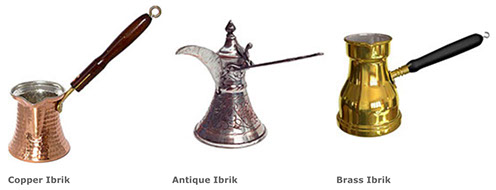
Boiled or Cowboy coffee
This is another direct brewing method, the results from which are never better, its fans opine, than when made over a campfire. Medium to coarse grounds are combined with boiling water, stirred (or not), let to steep for a minute or so, then strained (or not, depending on how much of a cowboy you are).
Vietnamese Coffee
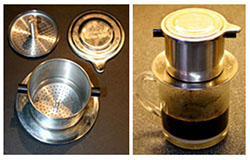 Mechanically, this brewing method is similar to manual drip. It utilizes a stainles steel filter that sits atop a coffee mug to make a single serving at a time. Traditionally, a coffee-chicory blend is used, often finely ground. The grounds are placed on the bottom of the filter (which resembles a miniature coffee pot), over which is fitted a metal screen to separate the grounds from the hot water, which is simply poured into the pot. The drip is typically slow through the bottom filter into the cup, and the richness of the brew can be controlled by varying the grind consistency and the tightness of the screw-on top strainer. The process takes practice to master, but the resulting beverage is generally stronger, thicker, and more flavorful than drip coffee. Customarily, an 8 oz. cup of Vietnamese coffee is made with 2 tablespoons of sweetened condensed milk. Like the Turkish brew described earlier, Vietnamese is a unique brew that every coffee lover should try at least once.
Mechanically, this brewing method is similar to manual drip. It utilizes a stainles steel filter that sits atop a coffee mug to make a single serving at a time. Traditionally, a coffee-chicory blend is used, often finely ground. The grounds are placed on the bottom of the filter (which resembles a miniature coffee pot), over which is fitted a metal screen to separate the grounds from the hot water, which is simply poured into the pot. The drip is typically slow through the bottom filter into the cup, and the richness of the brew can be controlled by varying the grind consistency and the tightness of the screw-on top strainer. The process takes practice to master, but the resulting beverage is generally stronger, thicker, and more flavorful than drip coffee. Customarily, an 8 oz. cup of Vietnamese coffee is made with 2 tablespoons of sweetened condensed milk. Like the Turkish brew described earlier, Vietnamese is a unique brew that every coffee lover should try at least once.
AeroPress
 The AeroPress brewing method employs a uniquely configured device and a process in which several variables combine to determine the characteristics of the brewed result. As with making Vietnamese coffee, experimentation is required to learn how to make the perfect cup. Unlike a gravity-induced process, the AeroPress uses a combination of infusion, similar to the the French press, and pressure, similar to espresso brewing. Invented in 2005 and manufactured by the California toy company Aerorbie, the main parts of the system include two, clear plastic cylinders—one a chamber for the water and coffee grounds, the other a plunger—and a black plastic filter holder for the proprietary paper filters. A fine grind for a single serving, or medium grind for two or more servings (four maximum), is placed in the chamber, resting on the filter. Water, heated to a recommended 165-175F is poured into the chamber, the grounds and the water are stirred together for ten seconds, then the plunger is inserted and plunged. The pressure in the chamber builds slowly, and the water is pressed through the grounds and filter into a cup or pot below. The result is an espresso-type coffee (and a "puck" of spent, compressed grounds) that can be turned into American coffee by adding four ounces of hot water, per serving.
The AeroPress brewing method employs a uniquely configured device and a process in which several variables combine to determine the characteristics of the brewed result. As with making Vietnamese coffee, experimentation is required to learn how to make the perfect cup. Unlike a gravity-induced process, the AeroPress uses a combination of infusion, similar to the the French press, and pressure, similar to espresso brewing. Invented in 2005 and manufactured by the California toy company Aerorbie, the main parts of the system include two, clear plastic cylinders—one a chamber for the water and coffee grounds, the other a plunger—and a black plastic filter holder for the proprietary paper filters. A fine grind for a single serving, or medium grind for two or more servings (four maximum), is placed in the chamber, resting on the filter. Water, heated to a recommended 165-175F is poured into the chamber, the grounds and the water are stirred together for ten seconds, then the plunger is inserted and plunged. The pressure in the chamber builds slowly, and the water is pressed through the grounds and filter into a cup or pot below. The result is an espresso-type coffee (and a "puck" of spent, compressed grounds) that can be turned into American coffee by adding four ounces of hot water, per serving.
The feedback about this relatively new brewing method is generally excellent, and can be found on Amazon and many of the coffee sites linked below. Our main concern about the AeroPress is that the manufacturer-prescribed water temperature during brewing is 25-35 degrees cooler than the commonly accepted norm. Even if the pressure created during the process makes up for the lower water temps and extracts the grinds sufficiently, the coffee is noy going to please those who like their cup steaming. The AeroPress is widely available for about $30.
Concentrate brewing
Sometimes called cold press or cold process, and popular in Latin America among other places, this method brews a relatively large amount of coarsely ground coffee in a small amount of hot or cold water. The grounds are steeped for several hours, often overnight. A thick concentrated liquor is produced (that can be stored for at least 48 hours before it begins to lose its flavor), and which is then is mixed with water, usually per serving, to make a cup of drinkable coffee. The final result is a fresh, light-bodied drink with little aroma. This is a convenient method for making iced coffee, because it requires only one brewing process to yield several glasses of iced coffee over the course of a few days.
Pod brewers
Apart from the AeroPress, coffee pod machines are the newest addition to the array of home coffee brewers, and they've become hugely popular in Europe and the US. The first of these machines, the Senseo, was manufactured and introduced by Philips in Europe in early 2001 and in the States during the spring of '04. It uses low air pressure (about a third of the pressure generated in a stovetop espresso pot) to force water, that's been pre-heated to a very suitable 193 degrees F in the machine's reservoir, through a package (the pod) of pre-measured (for a single serving), pre-ground coffee.

Following closely after the release of the Senseo, Melitta, Black & Decker, Mr. Coffee, Keurig, Bunn, and others marketed their own pod machines, and they sell for between $50—$250. (Hamilton Beach had a twenty-dollar model but it didn't do well.)
Initially, the coffee pods themselves, updated versions of the original pods introduced for commercial use in 1978 by the Italian giant Illy, had limited availability. In some cases, the machines were proprietary and could use pods from only one manufacturer. Now, there is more standardization among the coffee pods. They come in a large variety of flavors, from traditional Arabica and Robusta roasts, to pumpkin, pecan praline, and other flavored brews. Judging from consumer feedback on the Web, the spectrum of flavors is a huge attraction, along with the two-minute total brew time (including heating the water), and the freedom from cleaning messy grounds and filters. Opinions about the quality of the brewed coffee from these machines diverge, and indeed, the quality of the coffee itself varies depending on the pods used and the machine settings. Some machines will brew two pods at once for a stronger cup. We'll let you contemplate combining some of the exotic flavors currently available.
Iced coffee
Any of the brews discussed in this article is suitable for making iced coffee. A bit of experimentation will reveal which methods work best in a given situation.
Concentrate is the only non-hot brewing method. It takes several hours to brew — much longer than it would take for a pot of hot coffee to cool to room temperature — but it saves having to dilute fresh hot brew with ice cubes. This latter approach is fine as long as the original brew is strong, like espresso, and the ice is tasteless (replace your water filters regularly). The starting-with-hot-coffee approach is also advantageous if you drink your iced beverage with sugar or other flavorings, which will dissolve and blend better in hot coffee. Fans of Vietnamese appreciate this attribute, and we recommend the iced Vietnamese in this situation.
Summing Up
The goal of coffee brewing is to extract all, or as many as possible, of the organic elements in the grounds that make the coffee wonderfully flavofrul, and none of the elements that detract from the desired flavor. Because palates and tastes vary widely, and because one person's perfect brew is swill to another person, a relativistic perspective is one that makes sense for most of use when surveying the brewing options.
There are values, characteristics of the beverage itself, that figure into our subjective coffee drinking experience: taste, texture, temperature, caffeination. And there are attributes of each brewing method that are variously suitable to our respective situations: degree of user control over the process, difficulty, convenience, cost.
Once a method has been chosen, there are the mechanical brewing variables, most of which are key to all the options we describe in this article: quality of the ingredients, consistency of grind, water temperature, and extraction time. Whatever equipment is used, the best way to progress along the spectrum of home brew satisfaction is to experiment. Try a variety of beans and different roasts. Vary your grind, change filters (coffee and water), and try various settings on your machine. Brew. Taste. Repeat.
Coffee Resources
Coffee Websites:
Each of the following sites covers a range of coffee issues. Many include copious user participation.
CoffeeDetective.com - Uncovering the facts about coffee and coffee makers
CoffeeGeek.com - News, reviews, opinion and community for coffee and espresso
CoffeeHownd.com - Digging up the coffee industry
CoffeeResearch.org - Improving coffee quality through education and science
CoffeeReview.com - World's leading coffee buying guide
CoffeeSnobs.com - The name says it all. A forum-based site
CoffeeUniverse.com - Everything you want to know about coffee
Fair Trade Coffee - The coffee world in the context of global civic activism
Home-Barrista.com - Dedicated to the home espresso enthusiast
INeedCoffee.com - News, and a compendium of coffee-related articles
International Coffee Organization - news from the Executive Director
MadCoffeeMaker.com - News / articles about brews, machines, and other coffee issues
SingleServeCoffee.com - The one-coffee-cup lover's weblog
Coffee Related Directories:
These pages contain links to myriad coffee resources:
CoffeeHits.com - Chart of 150 coffee sites, ranked by traffic
Coffee Universe Resource Directory - Well-organized, and the largest directory for its inclusion of indirectly related areas
EspressoTop50.com - Coffee and espresso sites, ranked by traffic
HomePlanet.nl - All-around best directory of cofee resources we've seen
MadCoffeeMaker.com - Selected, categorized coffee-related sites
TheCoffeeIndex.com - Nearly 1000 categorized links
Links to Manufacturers:
These are links to companies that make gear for one or more of the brewing methods discussed in this article.
Alessi.com - French press; Neapolitan; espresso pots
Bialetti.com - Espresso pots
BlackandDecker.com - Wide variety of auto-drip machines, filters and other accessories
Bodum.com - French presses, espresso pots, manual drip pots, vacuum pots
Bonjour Products - Wide selection of French resses
Braun.com - Automatic-drip and pod coffee makers
Bunn.com - Automatic-drip and pod coffee makers
Capresso.com - Automatic-drip machines
Cuisinart.com - Wide variety of automatic-drip machines
Delonghi.com - Automatic-drip coffee makers
Farberware.com - coffee makers
Frieling.com - French press, manual drip, and filters for drip machines
HamiltonBeach.com - Wide variety of automatic-drip machines
Keurig.com - Pod machines
KrupsUSA.com - Automatic-drip machines
Melitta.com - Automatic-drip machines, manual drip pots, pod machines, accessories
MrCoffee.com - Automatic-drip machines, filters, accessories
Oster.com - One automatic-drip machine
Procter-Silex.com - Automatic-drip machines
Sunbeam.com - Automatic-drip machines
Technivorm.com - High-end drip machines
Vev-Vigano.com - Espresso pot

FOOD ENLIGHTENMENT
Copyright © 2019 FoodEnlightenment.com. All Rights Reserved. PLEASE SEE OUR PRIVACY POLICY.